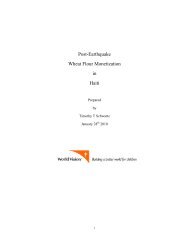Food Consumption Patterns Part 2
You also want an ePaper? Increase the reach of your titles
YUMPU automatically turns print PDFs into web optimized ePapers that Google loves.
114<br />
<br />
<br />
<br />
<br />
<br />
<br />
<br />
<br />
<br />
<br />
All labouyi (porridge) was broken into its constituent milk and whatever else they<br />
identified. But this should come with a caveat because very poor people, or people who are<br />
suffering hard times, may not use milk<br />
The importance of milk may also be underrepresented. Often respondents said coffee and<br />
milk or cornflakes and milk. And often when respondents said coffee or chocolate they<br />
may not have mentioned milk but, we assume from ethnographic experience, that it is, as<br />
with porridges, implied. Similar, even though not specified in the lists, all foods for babies<br />
of an age greater than neonate we assumed based on from interviews to be fortified with<br />
milk<br />
Almost all mentions of plantain are green plantains. Most mentions of bananas refer to ripe<br />
bananas<br />
Sweet manioc vs. bitter manioc is an important distinction. Baby foods are made of sweet<br />
manioc. Yet, the distinction was overlooked in the data gathering and simply noted as<br />
manioc<br />
Also, most misleading in the category of baby foods is that all starches were flour, farin,<br />
many of them made from local products such as arrowroot. Sometimes they are store<br />
bought and packaged. But often they are homemade. No distinction was made between<br />
homemade and store-bought<br />
Regarding juice, any starch (starchy vegetable or grain) was identified by the named starch<br />
combined with milk and, although we left sugar out of the list, it should be understood that<br />
they often add sugar.<br />
Sugar and edible oil are not adequately represented in the summary of foods. Nevertheless,<br />
noting the sugar and edible oil rule—wherever they can be added the most possible is<br />
added—we have emphasized their conspicuous role in the diet as a constant.<br />
All varieties of plantain were lumped under the single category of plantain. This was done<br />
despite the fact that a variety of plantain called kiyez in the North West of Haiti, pobon in<br />
Cape Haitian and ## in Port-au-Prince, is considered the most nutritious type of plantain<br />
and consistently distinguished from other plantain varieties as a baby food and fortifying<br />
for ill adults and children.<br />
There are dimensions of food preparation not adequately captured in this phase of the<br />
research but that will be pursued in greater depth during the next phase of the study.<br />
Specifically, foods are kole (embedded), pure (blended), they can also be graje (grated),<br />
and pile (smashed). In those categories discussed below we captured how foods are cooked<br />
(fried, boiled and sautéed) but we generally omitted the dimension of how they are prepared<br />
or transformed for consumption.<br />
Another dimension that we emphasize in the following analysis but that can and will be<br />
taken farther in the subsequent inquiry are foods that go together. For example, a rule is<br />
that all grains should have black beans either embedded in them or poured over them as a
















